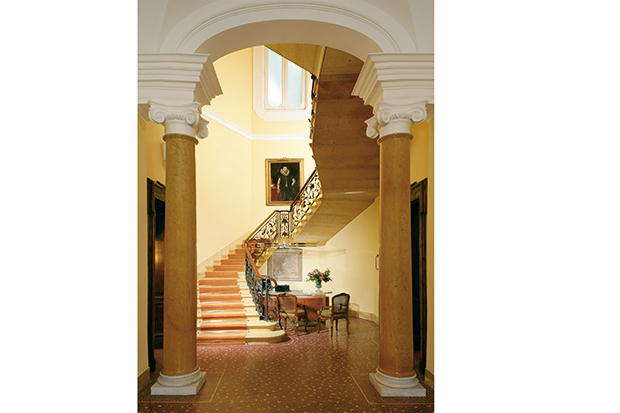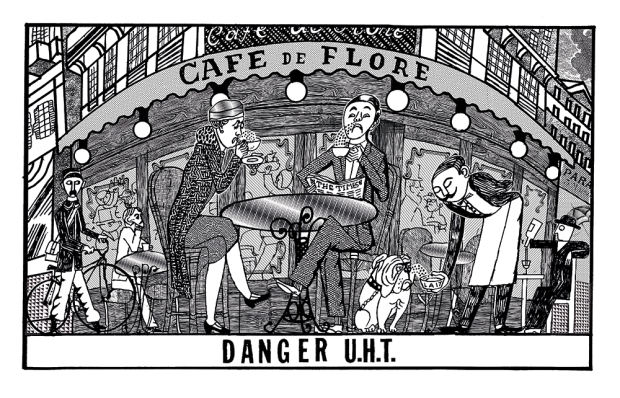My year was topped and tailed with trips to Rome. In March, as the blossom unfurled along the Tiber and the city’s churches prepared for Easter, I met four girlfriends from university, one of whom was working as a chef for the Rome Sustainable Food Project based at the American Academy. Then, in late November, I went back by myself and stayed at the Villa Spalletti Trivelli. It’s hard to say which was more pleasurable; Rome is Rome in every season.
In spring, we all crammed ourselves into a bedsit in an old pasta factory in the fashionable Trastevere district. During the day we pretended to be a bunch of young intellectuals studying Rome’s secrets as we lolled about in the gardens of the Academy, which is high on the Janiculum hill in the Villa Aurelia (built for Cardinal Girolamo Farnese in 1650).
Now a private institution, it is similar in concept to the British School at Rome. Each year a small group of American artists and scholars are awarded the ‘Rome Prize’ — an invitation to live at the academy for a year to pursue their work ‘in an atmosphere conducive to intellectual and artistic freedom, interdisciplinary exchange, and innovation’.
Concerts, exhibitions and lectures are held there, some of them open to the public, and private tours can be booked. The place feels almost preternaturally civilised. In the library, academics sit about drinking negronis while reading the Italian and American newspapers. The walls of the bar are crammed with self-portraits of all the artists who have studied there over the past hundred years.
One sculptor created a series of pasta moulds based on Francesco Borromini’s dome designs from churches around Rome. The chefs used them to create their own pasta master-piece: ravioli stuffed with courgettes from the vegetable garden and fluffy ricotta. The food was served to hungry scholars as they returned from their morning excursions around the city.
As dusk fell and the chefs were relieved of their duties, we joined them for dinner. They knew the best places: l’Osteria di Monteverde and la Taverna dei Fori Imperali for Roman staples such as cacio e pepe and fried globe artichokes; Retrobottega or Mater Matuta for fish. And Club Derrière just behind Piazza Delle Coppelle for a robust nightcap.
The best food market, the chefs told us, was the Mercato Testaccio — and the thing to eat there was a sandwich from Mordi e Vai called el panino all’allesso. A bread roll is dunked in dripping then layered with tender slices of beef.
In November I had a more old-fashioned Roman experience at the Villa Spalletti Trivelli, which stands opposite the Quirinal Palace, now one of the three official residences of the Italian president. The villa was built by Gabriella Rasponi, a niece of Caroline Bonaparte, younger sister of Napoleon I. Ten years ago it was converted into a hotel, which is now run by the Spalletti Trivelli family. This is not a hip part of town, but it is lovely. The home of Titus Pomponius Atticus, editor and friend of Cicero, once stood near the palace. So a stay at the Spallettis’ pile gives a glimpse into a different sort of Roman life to the one I had experienced earlier in the year.
The family’s art collection is displayed throughout the villa. Two Renaissance tapestries depicting spring and autumn hang in the drawing room and a Raphael Virgin Mary — complete with a cloud of dimple-bottomed cherubs — hangs above the free bar. Alongside the familiar canon of aperitifs and digestifs were bottles of wine from the Spalletti family vineyard. One morning I went out to their country estate a few hours outside of Rome and spent the day at the Pomario winery. When lunchtime arrived, the political scene was discussed over a plate of pasta and a glass of the family’s red. Italy’s referendum was looming; Britain’s had happened a few months ago. Trump had just won. But nobody seemed too bothered. Rome has seen its fair share of Trumps.
I had with me a copy of H.V. Morton’s A Traveller in Rome and spent my last day exploring some of the places he describes. Nothing has changed much since the 1950s when he visited. The cross above the dome of St Peter’s still turns gold in the morning light. Stray cats slink about the ruins. Men of all nations ponder the House of the Vestal Virgins. And tourists still toss pennies into the froth of the Trevi Fountain.
Morton liked to explore Rome while imagining himself as a host of characters. The Christian pilgrim arriving at the Vatican. The historian discovering the forum for the first time. The baker bustling about imperial Rome. The Englishman on his grand tour wearing his ‘Savile Row toga’. There are a million different characters you can play in the eternal city, and I would like to return soon to try out a few more. ‘One does not say goodbye to Rome,’ says Morton. Thankfully he’s right.
Got something to add? Join the discussion and comment below.
Get 10 issues for just $10
Subscribe to The Spectator Australia today for the next 10 magazine issues, plus full online access, for just $10.
You might disagree with half of it, but you’ll enjoy reading all of it. Try your first month for free, then just $2 a week for the remainder of your first year.















Comments
Don't miss out
Join the conversation with other Spectator Australia readers. Subscribe to leave a comment.
SUBSCRIBEAlready a subscriber? Log in